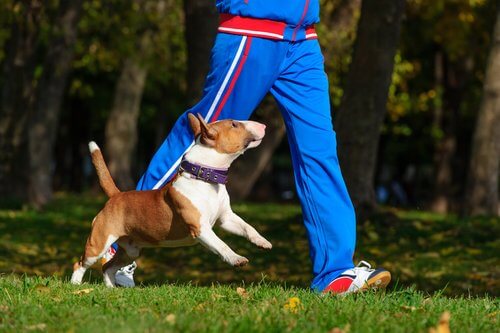The Best Ways to Enjoy a Great Dog Walk

A dog walk is always enjoyable as it gives you both a chance to bond in places outside your home. On this note, you can plan days of physical activity and take advantage of them. This brings many health benefits to you both and is a preventive measure to not fall into a sedentary lifestyle, which can lead to different diseases.
Dogs, like human beings, also need an adequate physical routine. On many occasions, the sedentary habits of the masters also affect physical performance.
In the same way that humans enjoy variety, and get bored of always going to the same place, our pets do too.
It’s important to design a sports or game routine. It must be suitable for the characteristics of the breed we have. Otherwise, it might only interfere with the athletic ability of our dog.
 Important tips to follow during a dog walk
Important tips to follow during a dog walk
It’s important that our exercise program takes place in open spaces. Find a place with little traffic to minimize the chance of accidents. A park or some other green area – where the pet feels close to nature and can run freely – would be ideal.
You can bring toys along so that your furry friend can play with them. But they should be highly resistant toys that won’t break easily. This way the dog won’t ingest little pieces, which will consequently turn your pleasant walk into an urgent visit to the veterinary.
Don’t forget to bring fresh water. If you both had a hectic day, packed with fun, and the temperature is high, a good sip of the liquid will be highly refreshing for both of you. You could also soak your dog’s face and body, in addition to them drinking it.
If the heat is extreme, avoid long walks. Excessive heat can lead to heat stroke that will have painful consequences, not only for the dog but for you as well. For this reason, take breaks for a few minutes now and then in order to regain strength, hydrate and relax.
To calculate the water that the animal might need, carry between 1 and 2 ounces of water per day for every pound of dog weight. For example, a 20-pound dog will require between 1 to 2 pints of water a day.
With regards to water, some precautions must be taken. At the end of the exercise, offer your dog water, but don’t give them too much of it at once. Above all, this will prevent abdominal distension.
More tips for your dog walk
It’s a good idea to first offer some ice and then a bowl of water so your dog can drink as much as they want. To know if your dog is well hydrated, pull some of the skin from behind their neck.
Do this using your index finger and thumb, trying not to hurt them. If they’re hydrated, their skin will soon return to its original place. Conversely, if the dog is dehydrated, the skin will maintain the form of a pyramid for a few seconds and slowly return to its place.

You can also check the hydration of your dog by looking at their gums. If they look wet and slippery, your dog is drinking enough water. But if they look dry and opaque, then you must offer them more liquid.
Bring bags along in order to pick up your dog’s feces. Sometimes exercise activates their digestive system and it leads to bowel movements. Also, some dogs might require sunscreen during hot summer days. For this reason, consult your vet to find out if your dog needs it.
The sun can be dangerous for a dog, especially if it’s a breed with short hair. Furthermore, when you shave your dog’s fur, you expose their skin to solar rays.
Similarly, hair acts as a protective barrier against ultraviolet rays. For this reason, shaved skin is a lot more vulnerable to sunburn. The proper way to cut your dog’s hair is to merely shorten it so that they carry a lighter load of it in the heat.
This text is provided for informational purposes only and does not replace consultation with a professional. If in doubt, consult your specialist.